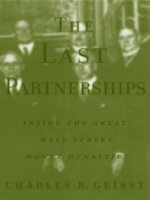THE LAST PARTNERSHIPS Inside the Great Wall Street Money Dynasties phần 1 pps
Bạn đang xem bản rút gọn của tài liệu. Xem và tải ngay bản đầy đủ của tài liệu tại đây (215.05 KB, 36 trang )
THE LAST
PARTNERSHIPS
This page intentionally left blank.
Charles R. Geisst
THE L
AST
PARTNERSHIPS
Inside the Great Wall Street
Money Dynasties
McGraw-Hill
New York Chicago San Francisco Lisbon
London Madrid Mexico City Milan New Delhi
San Juan Seoul Singapore Sydney Toronto
Copyright © 2001 by The McGraw-Hill Companies, Inc. All rights reserved. Manufactured in the
United States of America. Except as permitted under the United States Copyright Act of 1976, no part
of this publication may be reproduced or distributed in any form or by any means, or stored in a data-
base or retrieval system, without the prior written permission of the publisher.
0-07-138261-5
The material in this eBook also appears in the print version of this title: 0-07-136999-6.
All trademarks are trademarks of their respective owners. Rather than put a trademark symbol after
every occurrence of a trademarked name, we use names in an editorial fashion only, and to the benefit
of the trademark owner, with no intention of infringement of the trademark. Where such designations
appear in this book, they have been printed with initial caps.
McGraw-Hill eBooks are available at special quantity discounts to use as premiums and sales pro-
motions, or for use in corporate training programs. For more information, please contact George
Hoare, Special Sales, at or (212) 904-4069.
TERMS OF USE
This is a copyrighted work and The McGraw-Hill Companies, Inc. (“McGraw-Hill”) and its licensors
reserve all rights in and to the work. Use of this work is subject to these terms. Except as permitted
under the Copyright Act of 1976 and the right to store and retrieve one copy of the work, you may not
decompile, disassemble, reverse engineer, reproduce, modify, create derivative works based upon,
transmit, distribute, disseminate, sell, publish or sublicense the work or any part of it without
McGraw-Hill’s prior consent. You may use the work for your own noncommercial and personal use;
any other use of the work is strictly prohibited. Your right to use the work may be terminated if you
fail to comply with these terms.
THE WORK IS PROVIDED “AS IS”. McGRAW-HILL AND ITS LICENSORS MAKE NO GUAR-
ANTEES OR WARRANTIES AS TO THE ACCURACY, ADEQUACY OR COMPLETENESS OF
OR RESULTS TO BE OBTAINED FROM USING THE WORK, INCLUDING ANY INFORMA-
TION THAT CAN BE ACCESSED THROUGH THE WORK VIA HYPERLINK OR OTHERWISE,
AND EXPRESSLY DISCLAIM ANY WARRANTY, EXPRESS OR IMPLIED, INCLUDING BUT
NOT LIMITED TO IMPLIED WARRANTIES OF MERCHANTABILITY OR FITNESS FOR A
PARTICULAR PURPOSE. McGraw-Hill and its licensors do not warrant or guarantee that the func-
tions contained in the work will meet your requirements or that its operation will be uninterrupted or
error free. Neither McGraw-Hill nor its licensors shall be liable to you or anyone else for any inac-
curacy, error or omission, regardless of cause, in the work or for any damages resulting therefrom.
McGraw-Hill has no responsibility for the content of any information accessed through the work.
Under no circumstances shall McGraw-Hill and/or its licensors be liable for any indirect, incidental,
special, punitive, consequential or similar damages that result from the use of or inability to use the
work, even if any of them has been advised of the possibility of such damages. This limitation of lia-
bility shall apply to any claim or cause whatsoever whether such claim or cause arises in contract, tort
or otherwise.
DOI: 10.1036/0071382615
abc
McGraw-Hill
For Margaret & Meg
This page intentionally left blank.
ACKNOWLEDGMENTS ix
TIMELINE xi
INTRODUCTION 1
1 The Yankee Banking Houses: Clark Dodge
and Jay Cooke 9
2 “Our Crowd”: The Seligmans, Lehman
Brothers, and Kuhn Loeb 40
3 White Shoes and Racehorses: Brown Brothers
Harriman and August Belmont 81
4 Crashed and Absorbed: Kidder Peabody and
Dillon Read 114
5 Corner of Broad and Wall: J. P. Morgan
and Morgan Stanley 157
6 Corner of Wall and Main: Merrill Lynch and
E. F. Hutton 209
7 Unraveled by Greed: Salomon Brothers
and Drexel Burnham 240
8 The Last Holdouts: Goldman Sachs and
Lazard Freres 282
CONCLUSION 314
NOTES 317
BIBLIOGRAPHY 325
INDEX 329
CONTENTS
vii
Copyright 2001 The McGraw-Hill Companies, Inc. Click Here for Terms of Use.
This page intentionally left blank.
I would like to thank the following, all of whom helped contribute
information not found in the usual sources: Victor Grey of the
Rothschild Archive in London; Meg Ventrudo of the Museum of
American Financial History in New York; Steve Wheeler, archivist at
the New York Stock Exchange; and the staff of the Georgetown
University Library special collections department.
Kelli Christiansen of McGraw-Hill was instrumental in helping
keep the narrative on track and helped oversee the book process from
beginning to end.
My wife, Margaret, deserves special thanks for her extraordinary
patience while the book was being written.
ACKNOWLEDGMENTS
ix
Copyright 2001 The McGraw-Hill Companies, Inc. Click Here for Terms of Use.
This page intentionally left blank.
1818 John A. Brown & Co. founded
1832 Vermilye & Co. founded
1836 S. & M. Allen & Co. (founded 1808) fails
1836 Enoch Clark founds Clark Dodge & Co.
1837 August Belmont & Co. founded (dissolved in 1924)
1838 Drexel & Co. founded
1848 Lazard Freres founded (continues today)
1858 Lehman Brothers founded
1861 Jay Cooke leaves Clark Dodge & Co. to found Jay Cooke
& Co.
1864 J. & W. Seligman founded
1864 George Peabody & Co. becomes J. S. Morgan & Co.
1867 Kuhn Loeb founded
1869 Goldman Sachs & Co. founded
1871 Drexel & Co. merges with J. S. Morgan & Co. to become
Drexel, Morgan & Co.
1873 Jay Cooke & Co. fails
1873 Jay Cooke’s son-in-law reestablishes firm as Charles D.
Barney & Co.
1894 J. S. Morgan & Co. becomes J. P. Morgan & Co.
1903 E. F. Hutton founded
1905 Vermilye & Co. becomes William Read & Co.
1910 Salomon Brothers founded
1914 Merrill Lynch founded
1920 William Read & Co. becomes Dillon Read
1930 Brown Brothers merges with Harriman family interests to
become Brown Brothers Harriman (continues today)
TIMELINE
xi
Copyright 2001 The McGraw-Hill Companies, Inc. Click Here for Terms of Use.
1934 Drexel, Morgan & Co. reverts to its original name, Drexel
& Co.
1934 J. P. Morgan & Co. spins off Morgan Stanley (J. P. Morgan
continues today)
1937 Charles D. Barney acquires Edward B. Smith & Co. to form
Smith Barney & Co.
1966 Drexel & Co. acquires Harriman Ripley & Co. to become
Drexel Harriman Ripley
1970 Drexel Harriman Ripley becomes Drexel Firestone
1971 Drexel Firestone merges with Burnham & Co. to become
Drexel Burnham
1974 Kidder Peabody acquires Clark Dodge & Co.
1976 Drexel Burnham merges with William D. Witter and
acquires the name of a major investor in Witter to become
Drexel Burnham Lambert
1981 Salomon Brothers merges with Phibro to become
Phibro-Salomon (becomes Salomon Brothers again
in 1985)
1984 Shearson American Express acquires Lehman Brothers
1987 E. F. Hutton bought by Shearson
1990 Drexel Burnham Lambert files for bankruptcy
1994 Shearson American Express divests Lehman Brothers,
which continues today as Lehman Brothers
1997 Smith Barney merges with Salomon Brothers to become
Salomon Smith Barney, today a unit of Citigroup
1997 Bankers Trust & Co. acquires Alex. Brown & Co.
1997 Dillon Read acquired by Swiss Bank Corp.
1997 Morgan Stanley merges with Dean Witter to become
Morgan Stanley Dean Witter
1997 Alex. Brown acquired by Bankers Trust. Continues today as
unit of Deutsche Bank
1999 Goldman Sachs sells initial public offering
Timeline
xii
THE LAST
PARTNERSHIPS
This page intentionally left blank.
FOR MORE THAN 150 years, their
names were synonymous with Wall Street. The most successful be-
came the subjects of folklore, envy, and political vilification, and noto-
rious symbols of wealth and power. No longer household names today,
in the nineteenth century many had barroom songs and jingles writ-
ten about them. Before there were sports stars and pop musicians
dominating the news, they were among the first true celebrities in
the country.
They were, of course, the famous names behind the great Wall
Street partnerships. Some became extremely well known, while others
preferred to remain behind the scenes and tend to business without
attracting much attention. Their heyday was from the War of 1812 to
the end of World War II, when most Wall Street securities firms were
still organized as partnerships. A roll call sounds much like the social
register of New York, where most made their livings. Without their
business success, many of the country’s cultural institutions would
probably not have developed as significantly as they did. The Metro-
politan Opera, Metropolitan Museum of Art, and many of the other
significant cultural and educational institutions benefited from their
partners’ largesse over the years. The names on the buildings of many
college campuses read like a Who’s Who of banking, especially those
names famous before World War II.
The rise of the famous Wall Street banking dynasties is a testimony
to the rags-to-riches stories of the nineteenth century. A young immi-
grant came to the United States from Northern Europe and set up his
own humble business, usually peddling sundries door-to-door around
INTRODUCTION
1
Copyright 2001 The McGraw-Hill Companies, Inc. Click Here for Terms of Use.
the South or Midwest. Within several years, he graduated to the dry
goods business and was quickly opening stores in different states
before gravitating to New York. In another few years, he and mem-
bers of his family were in the banking business, financing bills of
exchange and trading stocks and bonds. In twenty to thirty years, his
firm was one of Wall Street’s elite. Within a generation, family mem-
bers were in the Social Register, members of New York’s elite clubs,
and contributors to the arts. They supplied capital to a country hun-
gry for it and also supplied millions of dollars to nonprofit institutions
equally hungry for the money necessary to grow.
This celebrity status often obscured the role of Wall Street firms in
American society before the Second World War. The banking dynas-
ties were not only the subject of much folklore, they were often its
source. American banking grew up along with the United States in the
nineteenth century, and its central figures became American heroes.
The name “Jay” was a favorite to give a newborn son because of Jay
Cooke’s success at selling Union war bonds to finance the Civil War. So
many people invested in them that Cooke became a household name
and an overnight success as America’s best-known banker. Without the
generosity of the Seligmans, Mary Todd Lincoln would not have been
able to live in a decent style in Germany, which was where she even-
tually she fled to after her husband’s assassination. They provided her
with a stipend when Congress was slow in granting pensions for presi-
dential widows. And Clarence Dillon became so well known that one
of his nicknames, the Wolf of Wall Street, became the title of a movie
in the late 1920s. A French vineyard continues to bear his name.
Stories like this are not simply the plots of a Horatio Alger chil-
dren’s novel but are true of many of Wall Street’s best-known invest-
ment banks. In fact, Alger himself was the tutor to Joseph Seligman’s
children after the Civil War and learned part of that partnership’s
growth firsthand from the patriarch of J. & W. Seligman & Co., one of
New York’s most respected banking houses in the nineteenth century.
Alger’s rags-to-riches stories owe much to his experiences as the
Seligmans’ tutor, listening to the family stories of how the brothers
came to America and got their start. But the Seligman example was
not an isolated one. He could easily have used Alexander Brown,
founder of Brown Brothers Harriman, or Marcus Goldman, founder of
THE LAST PARTNERSHIPS
2
Goldman Sachs, or Henry Lehman, founder of Lehman Brothers, as
his examples. The firms profiled in the first several chapters of this
book all have remarkably similar beginnings. How could so many
firms have had similar origins? The fact that they did illustrates some
of the basics for success in banking in nineteenth-century America.
The story became so well known that many other immigrants contin-
ued to follow the dream well into the twentieth century.
Occasionally, the Wall Street partners even proved inspirational.
Thorstein Veblen, the turn-of-the-century economist who coined the
phrase “conspicuous consumption” in his widely read Theory of the
Leisure Class in 1899, used August Belmont Sr. and Jr. as his models
since both were known to be lavish spenders. Not only did the
Wall Street partners help create the modern economy, they also
became its individual well-oiled engines of growth—consumers
whose demand helped propel the country into the twentieth century.
During the bull market of the 1990s, Wall Streeters were known to
spend lavishly, and more than one popular magazine was published
catering to their own peculiar form of conspicuous consumption. A
century earlier one of their most avid readers undoubtedly would
have been Belmont, whose wine bill before the Civil War was more
than $20,000 annually. Despite his success, his estate still had to be
sold upon the death of August Jr. to pay off debts.
More important, the Wall Street partnerships were an integral
part of the development of the country. Brown Brothers financed
the first transatlantic steamship service between the United States
and Britain. When one of its flagships, the Arctic, sank, it became
the greatest shipping disaster until the Titanic sixty years later. The
Brown family also suffered heavily, losing several family members in
the Arctic catastrophe. The partnerships helped finance every war
the country became involved in. Without Jay Cooke, the state of the
Union may have turned out much differently save for his expert sales-
manship in the mass marketing of Civil War bonds, a new phenome-
non in American finance. The Allies relied heavily on Wall Street’s
ability to raise funds during World War I. But the reparations
imposed on Germany after the war, guided by J. P. Morgan & Co.,
were so severe that German economic and political instability
resulted. The lessons were well remembered. During the Second
Introduction
3
World War, Franklin D. Roosevelt and his treasury secretary kept the
Street at arm’s length when raising funds to fight the Axis.
The partnerships often were shrouded in intrigue. August Belmont,
the immigrant banker who became the Rothschilds’ agent in New York,
was involved in several incidents over the years that cast a long shadow
over his business practices, especially when taking deposits from for-
eign investors, several of whom never saw their money again. Many of
the best-known, and foreign-born, New York bankers gathered secretly
before the Federal Reserve was created by Congress to discuss the
advantages and disadvantages of creating a new central bank. The ori-
gins of the Fed from those meetings at Jekyll Island, Georgia, have
never been forgotten and are often raised by conspiracy theorists who
believe that the Fed should be reformed, abolished, or purged of its
“clandestine” elements. Wall Street notables have continued to play a
major role in popular discussions of economic policy long after their
actual importance has faded.
A history of the partnerships also helps clear the smoke from some
of their reputations, which have become the subject of some intensely
populist, and wrongheaded, accounts of their influence and place in
history. Almost half of the partnerships discussed here were Jewish by
origin. J. & W. Seligman, Goldman Sachs, Lehman Brothers, August
Belmont, Kuhn Loeb, Lazard Freres, Salomon Brothers, and even
Dillon Read all had Jewish origins and exercised the influence of their
success the way the Yankee bankers of the same period did. Unfortu-
nately, they have been the subjects of conspiracy theories over the
years, ranging from that clandestine control of the Federal Reserve to
being the invisible power behind many a political throne. A clear view
of their history shows how many of the theories got started in the first
place, especially in the case of Belmont, but their outright fantasy
swamps the facts. In the nineteenth century, all bankers exercised
authority that would be incongruous in the contemporary world,
but the Jewish bankers did not exercise any unusual power. In fact,
they exercised less than their well-connected Yankee banker counter-
parts such as Brown Brothers, J. P. Morgan, Kidder Peabody, and
Clark Dodge.
The conspiracy theories do not stop with the Jewish banking houses,
but extend to the best known of all the Yankee bankers, J. P. Morgan.
THE LAST PARTNERSHIPS
4
His role in American finance is unique, and the mere thought of the de
facto power he exercised over the American banking system caused
most of the securities and banking legislation of the 1930s to be passed.
But the role and importance of Morgan is often misunderstood by seri-
ous students of history as well as by conspiracy buffs looking for a cabal
under every stone. Morgan was not simply a major figure in American
finance. He was the dominant figure for a generation, and his son Jack
was the dominant figure after him. Without their bank, Washington
would have suffered greatly during several key moments in American
history, probably defaulting on its debt on at least one occasion. When
Congress passed the Glass-Steagall Act in 1933, curtailing the power of
investment bankers, it was Morgan whom Congress had in its sights.
Few bankers could ever think of possessing such power even in the
unregulated world of American banking in the nineteenth century. The
history of his partnership is important on two levels: for the develop-
ment of Wall Street in general and as a mirror for the weaknesses of the
American banking system until the 1930s.
The very existence of the partnerships helps to underscore the pecu-
liar nature of what is known as American capitalism. Since Alexander
Brown began his firm in Baltimore before the War of 1812, the financ-
ing of all American wars and corporate endeavors traditionally has been
the province of several dozen privately held firms. Over the years, they
helped raise billions of dollars for a variety of causes. Without them, the
Mexican War, Civil War, and the Allies’ efforts in World War I might
have failed. Since there was no formal government apparatus in opera-
tion to raise funds, many of the partnerships made enough money in
the nineteenth-century conflicts to establish themselves in business.
Their collaborative efforts in financing the war in 1915 became the
basis for a government lawsuit charging antitrust collusion thirty years
later. In all cases, the Wall Street firms were accused of profiting at the
government’s expense, which was only partially true.
The history of Wall Street partnerships also exhibits several serious
shortcomings that have characterized the securities industry for
years. Most of the partnerships, especially those dating from the nine-
teenth century, had no formal management structures, and many
of their procedures for capturing business and keeping it were only
ad hoc at best. The firms would be divided on a simple division of
Introduction
5
labor, with partners overseeing areas that they knew best. Business
would develop following the success of the individual partners. When
they died or left their firms, there often was no formal mechanism for
keeping the business. Over the years, the most successful partner-
ships were those where a family kept control or was succeeded by
employees who knew the family formula for success. Otherwise, the
record of management success at many of the Street’s best-known
firms was not particularly strong.
But the recurring theme throughout the histories of the various
partnerships is that of capital. When a securities firm underwrote a
new issue of stock or bonds it would need to assume the risk of that
undertaking until it was sold. The actual cash needed for the trans-
action was obtained from a bank, but the firm still needed equity
capital on its books to obtain even a short-term loan. The capital
was supplied by either the partners’ funds or later by shareholders’
equity in the firm. The smaller that base became, the more difficult
it became over the years to underwrite larger and larger offerings of
new issues. After the Second World War, new issues became larger
and those firms that did not grow with their customers and the econ-
omy began to fall behind. Finally, even the traditional well-heeled
firms felt the need to go public. The remarkable part of the history is
how long some of the firms were actually able to hold out before suc-
cumbing to these modern pressures.
The partnerships remained the dominant form of business organiza-
tion for more than a century while the United States developed into an
economic superpower. They were able to last as long as the tenor of
everyday economic life remained slow to moderately paced. When new
underwriting deals became larger, requiring the partnerships to have
larger amounts of capital on their books, many were not able to respond
and folded shop or were acquired by larger firms. In the 1970s, many
Wall Street firms began to go public, selling shares to raise the addi-
tional capital needed to expand. Many of the older partnerships refused
to do so, finding the idea repugnant. Their fierce independence over
the years made the idea unthinkable, but by the 1990s almost all had
gone public. History had finally caught up with them.
The capital problem plagued Wall Street firms throughout their
histories. As we will see, capital also provided an element of disconti-
THE LAST PARTNERSHIPS
6
nuity to the development of Wall Street securities houses because it
was transient. Representing partners’ funds, it could be withdrawn by
older members of the firms upon death or retirement, and when that
occurred many firms found themselves in difficult straits. And the
problem was not confined to the smaller houses. J. P. Morgan & Co.
found itself short of capital in 1940 and was forced to go public, finally
succumbing to the pressure of a capital-intensive world.
The relationship between Wall Street and Washington also comes
to light through the partnerships. Almost since the beginning of the
Industrial Revolution, Washington has relied on Wall Street. Less
clear is Wall Street’s reliance on Washington. While the former is an
institutional relationship, the latter is more personal. The Seligmans
relied heavily upon their relationship with Ulysses S. Grant, forged
before the Civil War, to court business. Jay Cooke’s personal relation-
ship with treasury secretary Salmon Chase enabled him to win the
mandate for selling the enormous Treasury bond issues during the
war. Bankers from Kuhn Loeb and Lehman Brothers were instru-
mental in advising on the establishment of the Federal Reserve
between 1908 and 1912. Conversely, dozens of investment bankers
went to work for government agencies in both world wars. In the
postwar years, several have served as treasury secretaries, including
Douglas Dillon and Nicholas Brady of Dillon Read, William Simon of
Salomon Brothers, and Robert Rubin of Goldman Sachs. Pete Peter-
son served as Secretary of Commerce before joining Lehman Broth-
ers, while more recently Felix Rohatyn of Lazard Freres served as
Ambassador to France. But the institutional relationship is of vital
importance to Washington, since it is reliant upon Wall Street to
finance a large portion of government borrowing.
The adulation surrounding Wall Street bankers did not survive
the Crash of 1929 and the New Deal reforms of the 1930s. After the
1929 Crash, vaudeville comedian and erstwhile investor Eddie
Cantor quipped that “3,795 women bought certain investment trust
stocks because they had Goldman Sachs appeal.” But there was little
to swoon over once the smoke cleared from their investments. Much
of the allure of the famous family names and their highly regarded
reputations was seriously damaged by the Crash, and many never sur-
vived the turmoil of the 1930s. The excesses of the 1920s brought
Introduction
7
down August Belmont & Co. as well as Lee Higginson & Co.,
Boston’s best-known investment bank in the nineteenth century and
one of the most private. The Seligmans effectively gave up the invest-
ment banking business to concentrate on fund management. J. P.
Morgan’s vast empire effectively was fragmented by Congress with-
out anyone ever mentioning his name publicly. Equally, Goldman
Sachs and Kuhn Loeb were chastened by events in the early 1930s.
The partnerships emerging from the turmoil of the Depression
and World War II again led Wall Street in the 1950s when the bull
market began during the Eisenhower administration. But the pres-
sures created by an expanding consumer society proved their busi-
ness structures to be vastly out of date, and most eventually went
public or were acquired by the new powerhouse on Wall Street—the
wire house, or retail broker, which was moving into more traditional
areas like mergers and acquisitions and investment banking. These
securities firms were hardly from genteel stock and used marketing
as a key to their success, something the older investment banks
eschewed. Despite the changing nature of Wall Street and the domi-
nance of these newer full-service financial firms, the long-established
partnership names are still held in high esteem. The traditional
investment banking dynasties still retain their aura in an age where
mammoth financial institutions are adopting names that sound
uncomfortably bland, even in the new financial environment where
competition has won a victory over tradition.
THE LAST PARTNERSHIPS
8
1
THE SECURITIES BUSINESS had
very humble beginnings in the early part of the nineteenth century.
Some of the best-known names in investment banking began their
careers as itinerant merchants, peddling all sorts of wares throughout
the East and the South. Others sold commodities and traded on the
frontier. Although many of the early American bankers aspired to be
the American Rothschilds or Barings, few had the resources or the
family connections to follow in the Europeans’ footsteps. Baring’s
importance was probably best expressed by the Duke of Richelieu
after the Napoleonic Wars when he stated that there were six great
powers in Europe—Great Britain, France, Russia, Austria, Prussia,
and Baring Brothers. The Americans, on the other hand, were con-
tent to seize any opportunity that presented itself and develop it into
a profitable business. Between the War of 1812 and the Civil War, the
opportunities were expanding constantly, but the early partnerships
had to be industrious and farsighted as well. Without a clear view of
the future, many would not survive the rapidly changing American
business scene.
The years between those two wars proved to be a watershed in
American history. The country was shifting from a mercantilist and
agrarian-based economy to one that would soon be industrial on
a scale never imagined. Shortly after the Constitution was signed,
Alexander Hamilton, Secretary of the Treasury, recognized the need
for switching from an agricultural economy to one that would help the
THE YANKEE BANKING
HOUSES: CLARK DODGE
AND JAY COOKE
9
Copyright 2001 The McGraw-Hill Companies, Inc. Click Here for Terms of Use.
new nation become more self-sufficient. The United States was not
able to trade freely with many European countries because of barri-
ers put in place by the Europeans, and the lack of two-way trade was
retarding the country’s potential. In The Report on Manufactures
(1791), Hamilton wrote: “The embarrassments which have obstructed
the progress of our external trade have led to serious reflections on
the necessity of enlarging the sphere of our domestic commerce.”
The remedy would be to encourage manufacturing and thus make the
country less reliant on trade with Europe.
But what Hamilton envisioned as manufacturing—producing
ships, armaments, and other simple types of goods—could never have
foreseen the development of the steam engine, railroads, and steam-
ships, to name but a few early-nineteenth-century industrial innova-
tions. What Hamilton originally had in mind was manufacturing
goods that would aid American exports, which were still mostly agri-
cultural. Eli Whitney, the inventor of the cotton gin, was the personi-
fication of Hamilton’s ideas. While developing the cotton gin in the
1790s, he was able to help increase American cotton exports to
Europe almost fifty times over. And when he ran into financial
difficulties, he expanded into rifle manufacturing, helping to revolu-
tionize the firearms industry in the process. Like Cornelius “Com-
modore” Vanderbilt, Whitney was able to recognize the constantly
shifting winds of change and adapt to them rather than simply remain
the supplier of only one good or service. But his career showed that
obtaining adequate financing for his activities was difficult because
the Americans were long on ingenuity but short of the capital neces-
sary to bring their ideas to fruition. Unlike the Europeans, the Amer-
icans could not rely upon the long-standing banking houses to supply
them with capital or a wealthy domestic investing public that would
buy stocks and bonds. There was not enough private capital in the
new country to satisfy investment needs. The government could not
provide capital for the same reason: not enough money was available
from the citizenry. The early American bankers would prove that cap-
ital would not come from the government but from foreign sources
that were quick to finance any idea that could make them a buck.
In the early years of the republic, the federal government was not
a significant financial force, nullifying Hamilton’s vision of a national
THE LAST PARTNERSHIPS
10









